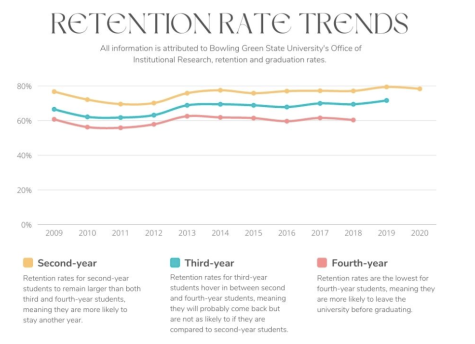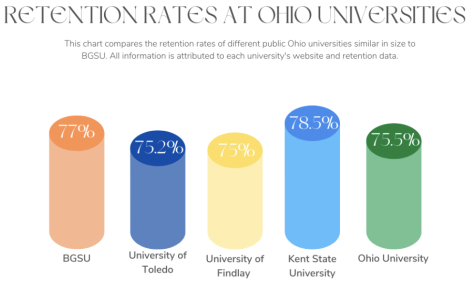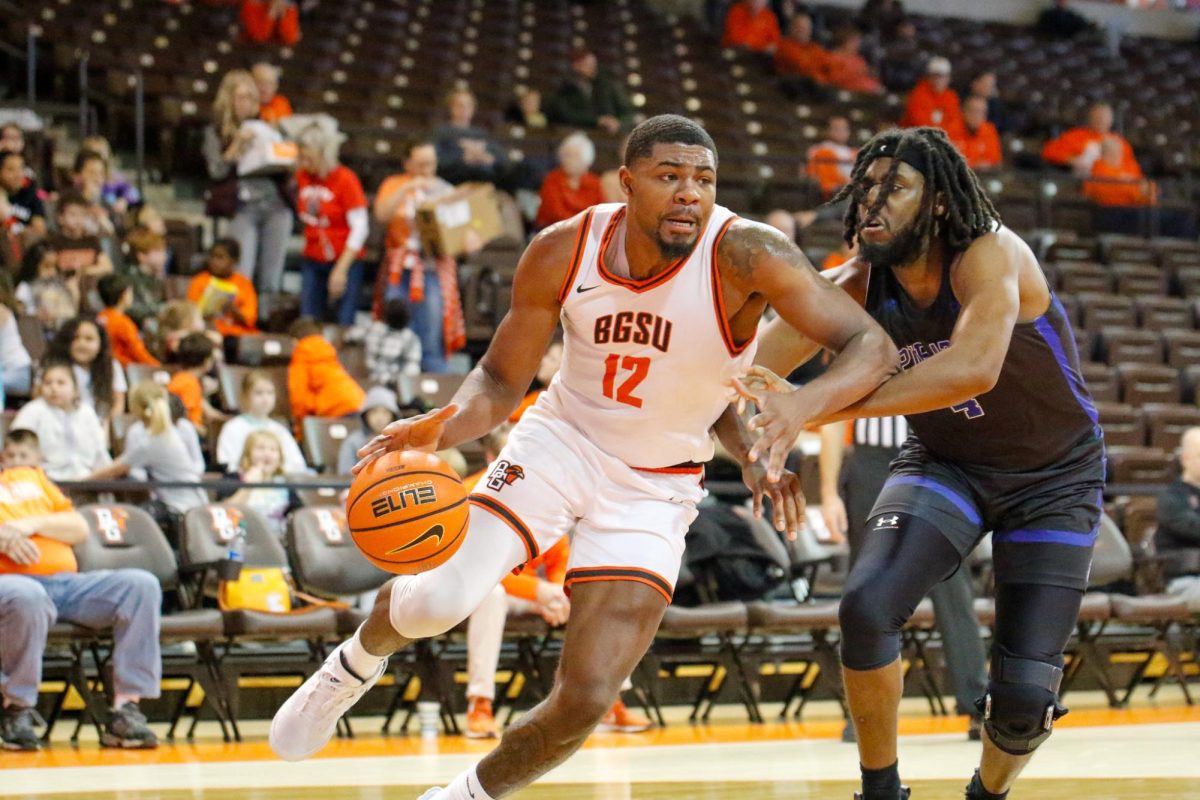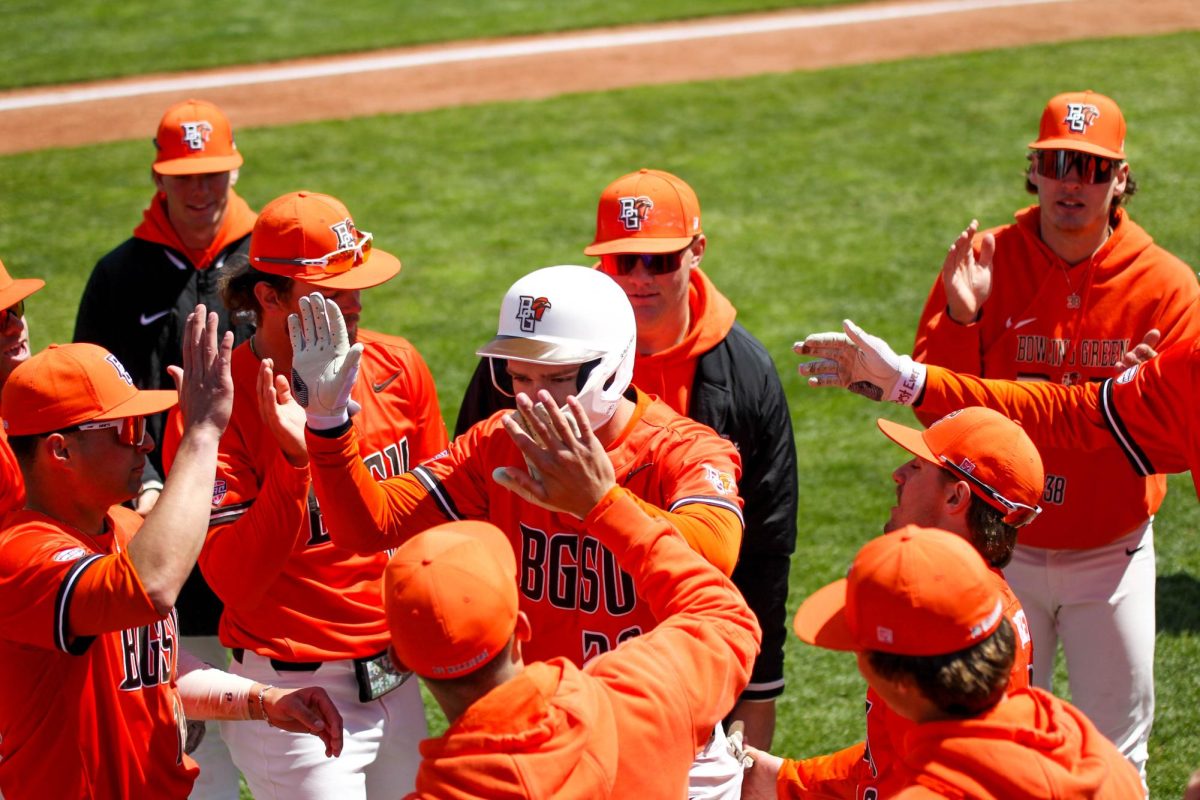As diversity chief departs, BGSU struggles to keep minority students enrolled
Jennifer McCary, BGSU Chief of Diversity and Belonging
January 17, 2023
When Jennifer McCary roamed Bowling Green State University’s campus as both an undergraduate and graduate student, she did not feel that she belonged there, especially in the classroom.
McCary received her bachelor’s degree in fine arts in 2005, and three years later earned her master’s in the college student personnel program. But her accomplishments didn’t come without struggles.
“Things were often happening to my artwork. That was just concerning, and I was heartbroken. A lot of times when my pieces were destroyed or vandalized, I would have to spend holidays here on campus re-doing work,” McCary said.
McCary said she was almost always the only person of color in her undergraduate courses, which affected how she felt in the classroom.
“I often felt like the art that I was producing wasn’t something that was often seen, and so, therefore, it wasn’t valued. I didn’t see anybody else who looked like me within the space,” McCary said.
However, she found acceptance from professor emeritus Katerina Ray of the School of Art, and sculpture professor Shawn Morin. They gave McCary the confidence, encouragement and attention she deserved to complete her undergraduate degree.
“Had it not been for Shawn Morin and Katerina Ray, I don’t actually know how I would have made it through that program because a lot of times, I felt like it wasn’t coincidental that my artwork was always being destroyed. And that was hard,” McCary said.
Since 2017, McCary has made it her mission to establish a more accepting campus as the Chief Diversity and Belonging Officer at the university where she once felt like she didn’t belong. But she will be wrapping up her time on campus at the end of January as recently accepted a position as chief of people and culture officer with the Toledo Museum of Art.
The Division of Diversity and Belonging, which is led by McCary, has worked for the past three years to promote diversity and a sense of belonging. It hosts initiatives, programs and events to help the Bowling Green community feel like they belong.
Like many university administrators, McCary’s days are filled with meetings, programs, answering emails and completing or hosting training sessions. But her work continues after the 8 a.m. to 5 p.m. shift is up.
McCary is responsible for 145 people, including 10 direct reports who she meets with on a weekly and bi-weekly basis, a doctoral student, an administrative assistant and her deputy chief.
She reports directly to BGSU President Rodney Rogers, and meets regularly with him, the university’s provost and chief of staff, attends presidential and executive council meetings and is on numerous campus and national committees.
Throughout her busy days, she still makes time for students, which is something important to McCary.
“The meetings with my staff end up filling quite a few hours of each week, and then my other time is set aside for students who want to meet for any reason,” McCary said.
The Hard Truth
Despite McCary’s long hours–and her staff’s efforts–data from BGSU’s Office of Institutional Research shows that retention rates of minority students have decreased over the past three years.
Retention rates in an educational setting are the percentage of students who re-enroll per year at a given institution. According to the Office’s 2021 Retention and Graduation Rates Fact Sheet, the university’s overall student retention rates have increased since 2017.
At BGSU, the retention rate for first-year students continuing into their second year is 78.3% but as students progress further into their academic careers, the retention rate decreases.

BGSU’s Division of Diversity and Belonging is larger compared to offices at nearby universities. This could lead some to believe the increased efforts would eventually increase the retention rates among students, but the Black student population has seen the opposite.
BGSU’s retention rate for the overall student body is average when compared to other MAC universities like Kent State University and the University of Toledo. The size of a university’s office or division doesn’t necessarily mean it will have an impact on retention.

According to the Office’s Retention and Graduation Rates graph, the total first-year students’ retention rates have staggered between 70% to 78% over the last ten years.
From fall 2020 to fall 2021, the retention rates for Black students at BGSU have decreased by 17%, while the retention rates for all students have decreased by 1.2%.

What’s Happening Now
The drop in retention means Black students aren’t continuing their academic careers at BGSU, which diminishes the Black student population. This could be one of the reasons that student organizations, like the Black Student Union, are struggling to find participation, despite the division and McCary’s efforts.
Taran Sherman, President of the Black Student Union, said his organization struggles with funding and participation. The Black student population at BGSU has been shrinking since the Fall of 2019.
According to the Retention and Graduation Rates graph, the freshman class in Fall 2019 had 224 Black students, the freshman Fall 2020 class had 171 students and the freshman Fall 2021 class had 156 Black students.
Black students may feel a lack of belonging within representation because the university employs few Black faculty and staff to whom they can identify with or relate to.
According to the Office’s Faculty and Staff Dashboard, there are 13 Black tenured faculty members, which has decreased from 15 because two left after Fall 2021.
There are four Black faculty members who are on the tenure track. These numbers stand in contrast to the university’s 308 white-tenured faculty members.
The university’s number of Black employees increased by two between 2020 and 2021, but then from 2021 to 2022, 35 Black employees left. Between 2019 to 2022 over 100 Black employees left.
According to the dashboard, student employees have made up 50-60% of the total Black faculty and staff count over the past six years.
Retention rates are dropping among Black faculty and staff, as they have within the Black student population.
But McCary is one of the strong Black women at BGSU who students can look up to. After working long days, and typically continuing to work into the evening, she spends time with her family.
McCary prides herself on cooking dinner for her husband and two daughters. After spending time with her family, she logs back onto a laptop to work on her Ph.D. in organization development and change through BGSU’s College of Business.
Sherman admires the work McCary does and appreciates her dedication.
Sherman said people may be given the opportunity to expand their knowledge and learn something new, but they have to want to do it for themselves, in order to take something away from the experience. BSU members try to make what they have been given into a lot.
“I don’t think people think about all that goes into putting on events. We don’t receive a lot of outside funding when it comes to things,” Sherman said. “We’re trying to turn a little into a lot and make the most out of every opportunity that we do have.”
Like any other student organization, BSU completes university paperwork to receive funding from the Student Budget Committee, which is then distributed between organizations through the Student Organization Allocation Board.
According to the Proposed Fiscal Year 2021 General Fee and Related Auxiliary Budgets, BGSU’s general fee allocation totaled $21.9 million, 2.25% of that given to the Student Budget Committee, which totaled $495,000.
$214,000 of that went to Undergraduate Student Government, Graduate Student Senate and University Activities Organization, leaving $281,000 for all other eligible student organizations.
However, after participating in the organization and speaking to those who once led it, Sherman noticed BSU was receiving less funding from the Student Budget Committee than it had in the past.
“If we go back to 2012, Black Student Union received a lot more money than we receive,” Sherman said. “When I talk to other BSU presidents, they always talk about how they had a bigger budget than what we have now.”
BSU acts as an umbrella organization for “Black and brown” student organizations on campus, and the groups often partner to host events. This allows the organizations to use their separate funding accounts to create larger events with strong intentions to bring bigger, better activities to students.
“When the money isn’t as comfortable, collaborating [works] because you get bigger crowds and it makes things a little bit cheaper when you’re splitting it 50/50,” Sherman said.
This collaboration provides a place for Black students to feel like they belong, especially since Black students made up only 7% of the undergraduate student population in 2020 according to the division’s Diversity and Belonging Comprehensive Strategy and Plan.
Despite the groups’ efforts to work together to fund events, student leaders like Dondreya Hendricks, BSU vice president said getting students to show up to events has grown difficult.
“People aren’t as active as they used to be… We do want people to actually want to come to these events,” Hendricks said. “Historically speaking, BSU used to pack out classrooms, and it’s really hard for us to do that now because people aren’t as involved as they used to be.”
Sherman said he believes the problem not only stems from the recent COVID-19 closures, but the long-stand mental impacts it could have left on people.
“You can try to change people’s minds, but you have to change their hearts first… You can put all of these programs in place, but if people don’t, they won’t,” Sherman said. “I don’t think it’s against the [Division of] Diversity and Belonging but since we put these initiatives in place, that doesn’t necessarily mean people are going to attend or necessarily like to hear things out.”
Current Diversity and Belonging Center
BGSU’s Division of Diversity and Belonging consists of 10 centers, programs and offices with various professionals staffed and responsible for hosting events, keeping their group motivated and making sure the division’s mission is kept top-of-mind, every day.
“I think [the Division of Diversity and Belonging] is something that is really woven throughout the fabric of who we are as an institution, and I think that that’s why you see this larger commitment, and so we have a division,” McCary said. “Our division is large, it is large in comparison to most other institutions, not even just those couple of comparisons.”
In addition to hosting events and providing programming, the division aims to ensure members of the campus community are protected under university and legal policies.
Lakeisha Dowlen, BGSU’s Title IX Coordinator, said during an October Undergraduate Student Government meeting that her office tackles inequity in a number of ways.
“We have policies in place to protect students, or at least prohibit acts of discrimination on our campus, and so we do that through prevention,” Dowlen said. “We do that through education and training that sometimes comes from my office, and we do that group policy that also comes to my office that sort of highlights prohibited behaviors and the process if anyone were to be subjected to any of these title nine or sexual misconduct behaviors.”
Dowlen isn’t the only one trying to ensure students from marginalized identity groups feel safe and comfortable enough at BGSU to finish their degrees. Staff from the 10 centers, programs and offices in the Division of Diversity and Belonging hosted 435 programs and initiatives from 2019 to 2020, according to the division’s Biennial Report.
Falcon Media reached out to the Administration for comment via email and received no response.













